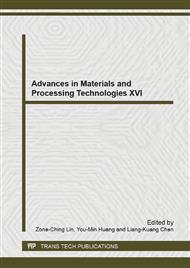p.524
p.530
p.539
p.547
p.555
p.563
p.570
p.577
p.584
Investigation of Gear Meshing Noise of Planetary Gear Mechanism for Hybrid Vehicles
Abstract:
In this report, an approach to calculating meshing frequency through the rotational speed of the sun gear, ring gear, and carrier of a planetary gear set is proposed. The proposed method includes a convenient contour map of the rotational speed of each component of the planetary gear sets and the meshing frequency. This contour map is used to estimate the relationship between the numbers of teeth, the rotational speed, and the meshing frequency. The results of experiments measuring acceleration via an accelerometer attached to the edge of a carrier clearly showed the meshing frequency and rotational component frequency at each rotational speed. A comparison of the acceleration at each meshing frequency shows that the vibrational level can be reduced by modifying the specifications of the planetary gear set (the number of teeth, number of pinions, radius of the carrier, etc.). The proposed method is an effective means of reducing vibration and noise in planetary gear sets.
Info:
Periodical:
Pages:
555-562
Citation:
Online since:
May 2014
Authors:
Keywords:
Price:
Сopyright:
© 2014 Trans Tech Publications Ltd. All Rights Reserved
Share:
Citation:


